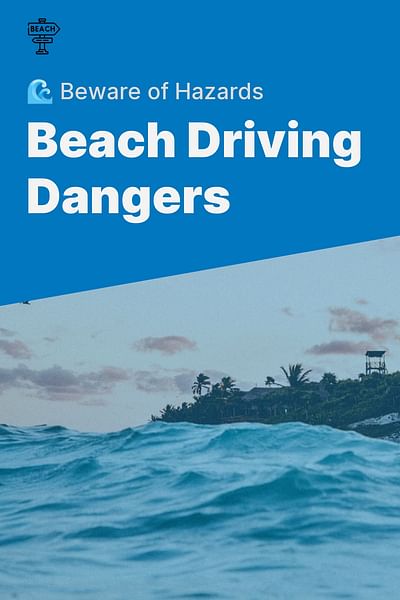Vivienne is an enthusiastic travel blogger with an unquenchable thirst for coastal exploration. Her years of experience navigating the world's most stunning beaches have made her an expert in beach driving. Vivienne is passionate about sharing her knowledge and tips to ensure others can also enjoy the thrill of beach driving in a safe and responsible manner.
Driving on the beach can be an exciting and adventurous experience, but it's important to be aware of the hazards that come with it. Here are some of the hazards you should keep in mind before hitting the sand:
1. Soft Sand: One of the biggest hazards of beach driving is encountering soft sand. Driving on soft sand can cause your vehicle to get stuck, especially if you don't have the right tires or if you're not familiar with driving on sand. It's important to stay on designated beach driving areas and avoid venturing into areas with soft sand.
2. Tidal Changes: Another hazard to be aware of is tidal changes. The tides can dramatically affect the condition of the beach, making it more difficult to drive on. It's important to check the tide schedule before heading out and plan your beach driving accordingly. Driving during low tide is generally safer and easier.
3. Saltwater Exposure: Driving on the beach means exposing your vehicle to saltwater, which can cause corrosion and damage to your vehicle's undercarriage, brakes, and electrical systems. It's important to thoroughly rinse your vehicle with fresh water after beach driving to remove any salt residue and prevent long-term damage.
4. Wildlife: Beaches are home to a variety of wildlife, including birds, turtles, and other marine animals. It's important to drive cautiously and be mindful of the wildlife around you. Avoid driving too close to nesting areas or disturbing the natural habitat of these animals.
5. Pedestrians and Beachgoers: Beaches are popular destinations for pedestrians and beachgoers. It's important to drive at a safe speed and be aware of your surroundings to avoid accidents. Always yield to pedestrians and give them plenty of space.
6. Weather Conditions: Weather conditions can greatly impact the safety of beach driving. High winds, heavy rain, or storms can make driving on the beach extremely dangerous. It's important to check the weather forecast before heading out and avoid driving on the beach during inclement weather.
To ensure a safe and enjoyable beach driving experience, here are some precautions you should take:
- Familiarize yourself with the rules and regulations of beach driving in the area you plan to visit. Each beach may have different rules and restrictions, so it's important to know and follow them.
- Make sure your vehicle is properly equipped for beach driving. This includes having the right tires, a shovel, a tow strap, and a tire pressure gauge.
- Lower your tire pressure to increase traction on the sand. This will help prevent your vehicle from getting stuck in soft sand.
- Drive at a safe and cautious speed. Avoid sudden accelerations or abrupt turns, as they can cause your vehicle to lose traction.
- Keep a safe distance from other vehicles on the beach. This will give you enough time to react and avoid collisions.
- Always be prepared for emergencies. Carry a first aid kit, a fire extinguisher, and a cell phone with a fully charged battery in case you need to call for help.
By being aware of the hazards and taking the necessary precautions, you can have a safe and enjoyable beach driving experience. Remember to always prioritize safety and respect the beach environment. Happy beach driving!














